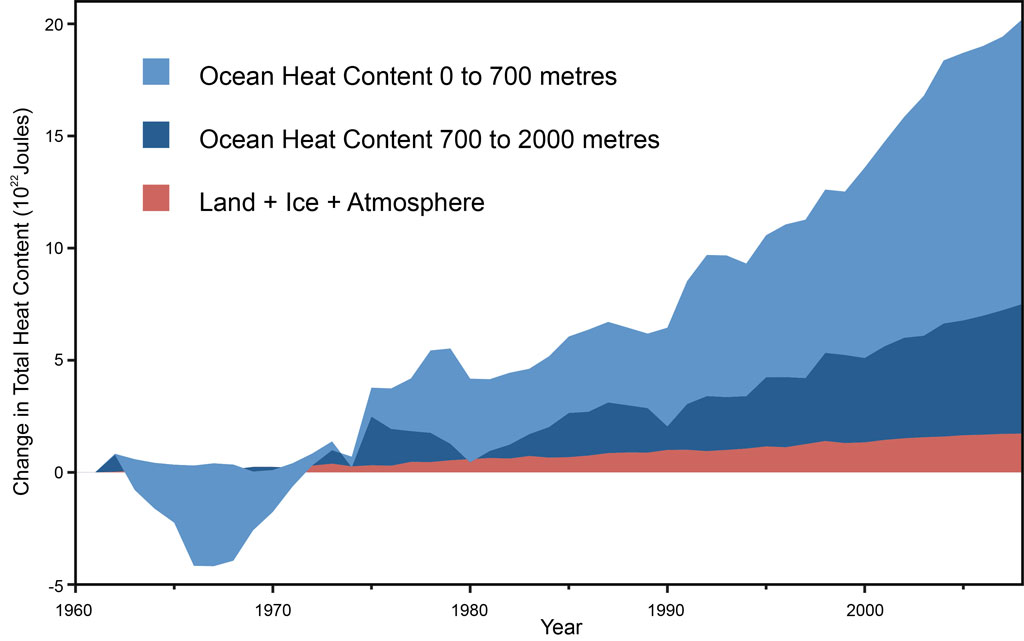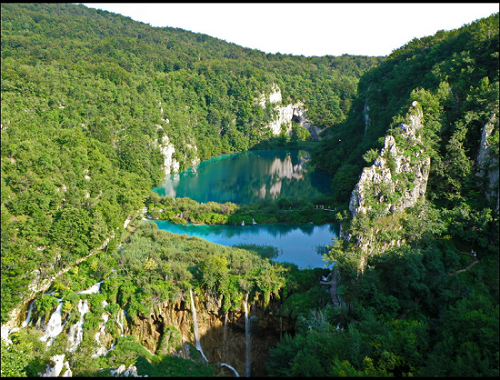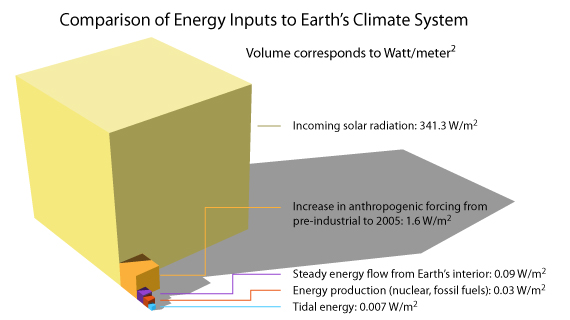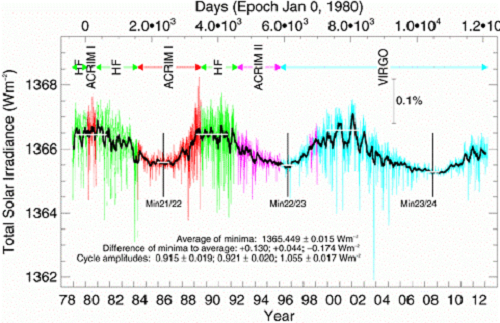 Global heat accumulation data (ocean heating in blue; land, atmosphere, and ice heating in red) from Nuccitelli et al. (2012)
Global heat accumulation data (ocean heating in blue; land, atmosphere, and ice heating in red) from Nuccitelli et al. (2012)The Earth is warming, accumulating heat. As has been discussed recently this extra heat is building up at a rate of around 250 trillion Watts (Joules per second). Recently Skeptical Science’s Bob Lacatena published his Heat Widget highlighting that this heat build-up is the equivalent of adding the energy of 4 Hiroshima bombs per second to the Earth (or 1.8 Hurricane Sandy’s per second or 4 magnitude 6 earthquakes per second). You can see it ticking away in the sidebar on the right.
Most of the extra heat that is being added to the Earth's climate systems is going into the oceans - over 90% of it on average. In contrast the atmosphere, which is the part of the climate system that we directly experience, is only accumulating 2-3% of this extra heat. To assess what is happening to Earth's climate we need to look at all parts of the system.
 Global heat accumulation data (ocean heating in blue; land, atmosphere, and ice heating in red) from Nuccitelli et al. (2012)
Global heat accumulation data (ocean heating in blue; land, atmosphere, and ice heating in red) from Nuccitelli et al. (2012)
So let’s explore this heating a little, where it comes from and what the significance of it is. There are some surprises. (For the calculations behind this post take a look at the notes at the end)
To quote Julie Andrews, we need to start at the very beginning.
The heat that warms the Earth comes from the Sun. The Earth is bathed in it every second of every day; it has been for the last 4 ½ billion years. The strength of sunlight at the Earth’s orbital distance from the Sun is equal to around 341 Watts for every square meter of the Earth’s surface. Of this, on average 30% gets reflected back into space by Earth's atmosphere (e.g. by clouds), and Earth's surface (particularly from snow and ice covered surfaces) and thus does not contribute any heating. Leaving around 239 Watts/m2 that is absorbed.
239 Watts - that doesn’t sound like very much! A few light bulbs, perhaps? But the surface of the Earth is around 510 trillion m2 in area. So that adds up to around 122,000 trillion Watts - sounds a bit more impressive now doesn’t it? But still unreal, a bit hard to grasp. That’s around 1900 Hiroshima bombs of heat every second.
The amount of energy flowing in from the Sun every single second is enormous. So just what could this much heat potentially do? Well it would boil Sydney Harbour dry in just 12 seconds!

THEN it would boil all the world’s oceans dry in around 900 years!
THEN it would melt the entire Earth’s crust in around 4,000 to 5,000 years!!!
The Himalayas would melt in decades! The Earth would have no solid surface, just molten lava all the way down. Don’t believe me, go check my calculations at the end. All of geology, plate tectonics, the raising of mountain ranges, volcanoes etc. are just a gnat on an elephant's back in comparison.
So why isn’t the Earth a giant ball of lava? Because it doesn’t just absorb heat from the Sun. It also radiates heat out to space in the form of Infrared Radiation (IR). If the Earth is able to lose heat to space as fast as it gains it from the Sun it doesn’t warm up, it’s temperature stays stable; the oceans don’t boil; the mountains don’t melt.
It is all about this balance, a small (in percentage terms) difference between two absolutely huge energy flows. If the balance is maintained so that the two flows are equal then the Earth neither warms nor cools. This is the Earth’s Radiative Heat Balance. It doesn’t matter how large the flows are if they balance and cancel out.
Get the balance right and:

Photo: Miroslav Vajdi?
But if they don’t balance out, if we get the balance wrong:

Photo: US Geological Survey
So just how closely does everything have to balance in order to keep things ‘nice’? We have measured an imbalance that is occurring now - 250 Trillion Watts worth of imbalance. Compared to the total heat flowing through the system this is an imbalance of around 1 in 500 – 0.2%. Sounds pretty tiny doesn’t it, 0.2%. Well let’s do some more calculations. What would a ‘tiny’ imbalance of 0.2% do?
It would now take all of 100 minutes to boil Sydney harbour dry.
It would take merely 440,000 years to boil the oceans dry.
And it would now take all of 2 to 2.5 million years to melt the Earth’s entire surface. The Himalayas don’t melt for at least the first 500 thousand years while the oceans are boiling, then they are gone in all of a few 10’s of 1,000’s of years– what a relief! But then again they took millions of years to form. So even this ‘tiny’ imbalance still completely dwarfs all of geology – a sparrow on an elephant's back.
And the geological evidence is absolutely clear cut. The crust has never melted. This has never, ever happened in billions of years! If it had, mountains would have melted away, sedimentary rocks like sandstone could not possibly exist, all the fossils would have been destroyed, and trivial details like coal deposits or diamond deposits would have been incinerated. If the crust had ever melted in the past then most of what occupies a modern geologists’ working day would not exist.
Oh, and all life on Earth would have been wiped out. Since you are reading this we can safely assume that this didn’t happen.
When the amount of energy flowing into and out of the Earth is so huge, the balance between these flows needs to be maintained to an absolutely exquisite precision or ‘big things’ happen. But they never have, so this exquisite balance must have been maintained well enough.
Thankfully this balance is easy to maintain. When the Earth is out of balance it warms or cools. This changes how much energy is being radiated to space and restores the balance. So the balance is self-correcting, self-maintaining and very precise. But the Earth has to warm or cool to maintain this balance.
So what do we know about this current imbalance of 250 trillion Watts?
Simple, it can’t last! Either the cause of the imbalance needs to be removed, or the Earth will restore the balance another way; by warming up enough. If it is a choice – the Earth warms a bit or the oceans boil away - which do you think will happen?
What might be causing the imbalance? Might it be heat flowing from within the Earth? Apparently not. Pollack et al 1993 estimated total geothermal heat flows from within the Earth at 44.2 trillion Watts. This is only around 1/6th of the observed heat build-up (and 0.025% of the total heat flow from the Sun). And geothermal heat flows don’t change suddenly and has always occurred so there is no reason for this to suddenly start causing extra heat build-up now so any contribution from geothermal is likely much smaller than even 1/6th. Besides, data from borehole studies show that the ground is actually warming from above and also the oceans are warming from the top down – not what would occur if geothermal heat was the cause. As Andy Skuce discusses here, no terrestrial heat source is remotely large enough to be the source of the extra heat we are seeing.

So if the extra heat we are seeing isn’t coming from anywhere here on the Earth then it must be coming from somewhere off the Earth. Because it can’t be appearing by magic! Either more heat is flowing into the Earth from the Sun, or less is flowing out to Space.
The Earth’s Radiation Balance has been disturbed. That’s not speculation, that’s what the evidence says.
Perhaps the Sun is getting warmer? No. If anything it is getting ever so slightly cooler:

Figure 4. The PMOD composite TSI as daily values plotted in different colors for the different originating experiments. The difference between the minima values is also indicated, together with amplitudes of the three cycles
These are measurements by satellite of the heat output from the Sun since the late 70’s, over several solar cycles. They go up and down a little over the cycle but not by much, only about +/- ½ a Watt/m2 compared to an average of around 1366 Watts/m2. And the long term trend is very slightly down; certainly not up.
So a warmer Sun isn’t warming the Earth. Could it be that more of the existing sunlight is being absorbed by the Earth? Again no. If more sunlight were being absorbed, perhaps due to a change in cloud cover, then we would expect to see more warming when the Sun is shining – in daytime and summer. Are day temperatures rising faster than night? No! (Braganza 2004, Alexander 2006, Zhou 2009). Are summer temperatures rising faster than winter? No! (Braganza et al 2003, Braganza et al 2004)
None of the evidence supports the idea that disturbance in the radiative balance is caused by the Earth absorbing more sunlight. Which only leaves less heat being radiated to space as the explanation. Which is what an increase in the strength of the Greenhouse Effect would do. Sound familiar?
To recap.
Shortly after Bob Lacatena published his widget a climate change skeptic, in a ‘Me Too, Me Too’ kind of moment, hacked Bob’s code to produce their own widget showing the total flow of heat coming in from the Sun. What they failed to mention is that this is also the magnitude of the heat flows from the Earth out to space as well. They got the numbers sort of right (although they failed to account for heat not absorbed due to reflection) but totally failed to understand the significance of what they were saying.
It is precisely because the flows of heat in from the Sun then back out to space are so stupendous that anything that leads to even a tiny disruption in the balance of these two flows can have substantial consequences. And we are disrupting that balance.
One might be asked a simple question: What is Climate? A simple answer could be: Climate is primarily the Earths's Radiative Heat Balance. Everything else is just local details.
Notes:
Here is how I have done the calculations:
1. The strength of sunlight at the Earth’s distance from the Sun is a 1366 Watts/m2. But in order to relate sunlight absorbed by the Earth, which depends on the frontal area the Earth presents to the Sun, with radiation from the Earth’s surface, which comes from the entire Earth’s surface, the standard convention used is to convert solar radiation to an equivalent value for the entire Earth’s surface by dividing by 4. So 341 Watts/m2.
2. The Earth’s Albedo (Total Reflectivity) is approximately 0.3 so this gives us 239 Watts/m2 actually absorbed by the Earth
3. To calculate how much heat is needed to boil a quantity of water dry I have assumed the water temperature must be raised from 0 C to 100 C then boiled away. Most of the deep oceans are very cold, close to 0 so this is a reasonable approximation.
- To know how much heat is needed to warm something we need to know it’s Specific Heat – how much heat is needed to raise 1 kg of material by 1 C. For water this is around 4.1813 KJoules/(Kg C)
- To vaporise (boil) a liquid we need to know its Latent Heat of Vaporisation – how much heat is needed to vaporise 1 kg of liquid. For water this is 2260 KJoules.
- So to heat then vaporise 1 kg of water requires (4.1813 * 100) + 2260 = 2678 KJoules
4. Similarly to calculate how much heat is needed to heat then melt a quantity of rock I assumed that:
- We need to raise the temperature of the rock by 500 C. Virtually all rocks are molten by 1000 C. And the surface temperature of the Earth is 15 C. So rocks at the surface need to be warmed by around 1000 C while those at the greatest depths need hardly be warmed at all. As we move down through the crust the temperature increases approximately linearly with depth. So the warming needed, averaged over the full depth of the crust would be around 500 C.
- The specific heat values vary for different rock types (see page 87) but they are mostly in a range from 0.6 to 1.1 KJoules/(Kg C). So I have used a value of 0.85 K Joules/(Kg C)
- For rock we are melting it not vaporizing it so we need to use the Latent Heat of Fusion. This varies for different types of rock (see Table 4) but is typically around 420 K Joules/Kg.
- So to heat then melt 1 kg of rock requires (0.850 * 500) + 420 = 845 KJoules
5. Sydney Harbour has a volume of 562 million cubic metres at high tide so that is approximately 562,000,000,000 kilograms. So this needs 1.5 * 1018 Joules to boil dry.
6. The world’s oceans have a volume of around 1.3 billion km3 – 1.3 * 1021 kg (assuming a density of 1000 kg/M3 as an approximation). So 3.48 * 1027 Joules to boil dry.
7. Estimating the mass of the Earth’s crust is more approximate. This source gives a mass of 1.9 * 1022 kg. So 1.6 * 1028 Joules to heat and melt the Earth’s crust.
8. So a heat flow into the Earth of 239 watts/M2 over an area of 510 trillion square meters is 121,890 trillion watts
9. From 5 and 8 this will boil Sydney Harbour dry in 1.5 * 1018/1.2189 * 1017 which is 12.3 seconds.
10. From 6 and 8 this will boil the oceans dry in 3.48 * 1027/1.2189 * 1017 which is 28,550,332,267 seconds - 905 years.
11. From 7 and 8 this will melt the crust in 1.6 * 1028/1.2189 * 1017 which is 131,265,895,479 seconds - 4160 years.
12. From 5, a heat imbalance for the Earth of 250 trillion Watts will boil Sydney Harbour dry in 1.5 * 1018/2.5 * 1014 which is 6000 seconds – 100 minutes
13. From 6, a heat imbalance for the Earth of 250 trillion Watts will boil the oceans dry in 3.48 * 1027/2.5 * 1014 which is 13,920,000,000,000 seconds - 441,098 years.
14. From 7, a heat imbalance for the Earth of 250 trillion Watts will melt the crust in 1.6 * 1028/2.5 * 1014 which is 64,000,000,000,000 seconds - 2,028,037 years.
Posted by Glenn Tamblyn on Thursday, 23 January, 2014
 |
The Skeptical Science website by Skeptical Science is licensed under a Creative Commons Attribution 3.0 Unported License. |